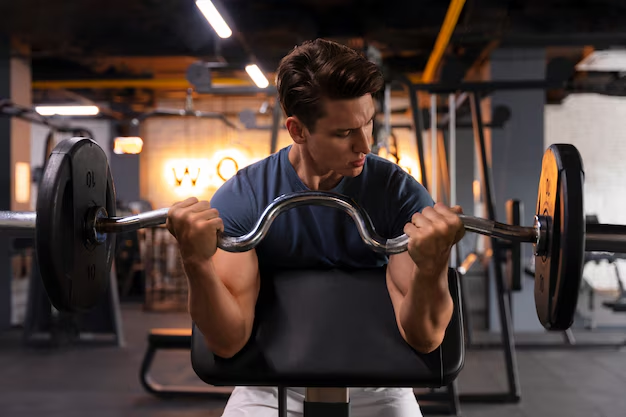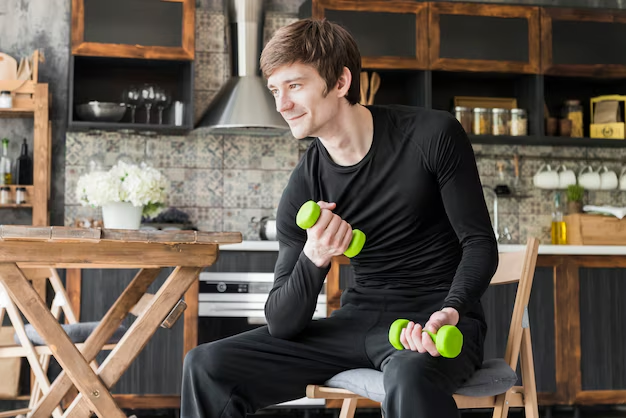Sports fitness is not just about working out; it’s about pushing the limits of your body and mind to unlock the best version of yourself. Whether you’re an aspiring professional athlete or simply someone who wants to perform better in your favorite sport, understanding the principles of sports fitness will help you reach your full potential. In this ultimate guide, we’ll explore the key components of sports fitness, from strength training and endurance to flexibility and recovery, giving you the tools to improve your performance and reach your goals.
Key Takeaway
To unlock your full potential, it’s essential to adopt a balanced fitness routine that integrates strength, speed, flexibility, recovery, and nutrition. Stay consistent, push yourself to improve, and remember that sports fitness is a continuous journey of growth and development. With the right mindset and approach, you can achieve excellence in any sport.
What is Sports Fitness?
Sports fitness refers to the level of physical conditioning and performance abilities an athlete possesses that are specific to their sport or activity. This includes strength, endurance, agility, flexibility, speed, and mental focus. While general fitness is important for overall health, sports fitness is targeted to help athletes perform their best in a specific sport, such as football, basketball, tennis, or running.
Achieving sports fitness involves more than just lifting weights or running long distances. It requires a well-rounded approach that includes:
- Strength training for power and muscle growth
- Cardiovascular fitness for stamina and endurance
- Agility and speed drills for quick reactions and movement
- Flexibility and mobility work to prevent injuries and improve range of motion
- Recovery strategies to avoid burnout and injuries
- Nutrition to fuel the body for optimal performance
Let’s break down each of these components and see how they contribute to unlocking your full athletic potential.
Strength Training: Building Power and Muscle

Strength is the foundation of sports fitness. It’s not only about lifting heavy weights; it’s about developing muscle power, stability, and endurance that directly improve athletic performance. Stronger muscles improve your ability to jump higher, sprint faster, lift more, and withstand the physical demands of any sport.
Key Aspects of Strength Training for Sports Fitness:
- Compound Movements: Focus on multi-joint exercises such as squats, deadlifts, and bench presses that work several muscle groups simultaneously. These movements simulate real-life and sport-specific actions.
- Olympic Lifts: Power cleans, snatches, and jerks develop explosive power, which is essential for athletes in sports requiring quick movements and reaction times.
- Bodyweight Exercises: Push-ups, pull-ups, lunges, and planks improve muscular endurance and help stabilize smaller muscles that are often neglected in traditional weight training.
- Core Strength: A strong core is crucial for every sport. Engaging in exercises like planks, Russian twists, and leg raises can help improve balance and stability, which are necessary for effective movement in any sport.
Incorporating strength training into your routine, 2-3 times a week, will help build lean muscle and increase your power, enabling you to perform at a higher level in your sport.
Cardiovascular Fitness: Boosting Stamina and Endurance
Cardiovascular fitness is the ability of your heart and lungs to deliver oxygen to your muscles efficiently. For many sports, cardiovascular conditioning is critical. Whether you’re sprinting during a football game or running long distances in a marathon, having a well-conditioned cardiovascular system allows you to sustain your performance for longer periods of time without fatiguing.
How to Improve Cardiovascular Fitness:
- Interval Training (HIIT): High-Intensity Interval Training is one of the most effective ways to build cardiovascular endurance. It involves alternating periods of intense activity with short recovery intervals. This type of training mimics the stop-and-start nature of most sports, improving both aerobic and anaerobic capacity.
- Endurance Running or Cycling: Long, steady-state runs or bike rides improve your aerobic capacity, building the stamina necessary for longer events.
- Circuit Training: Combining strength training with short bursts of cardiovascular work can improve both muscular endurance and heart health, simulating the real demands of sport.
Cardiovascular conditioning should be tailored to the specific demands of your sport. If you’re a long-distance runner, you’ll focus more on steady-state runs, while sprinters will benefit from high-intensity intervals.
Agility and Speed: Enhancing Quickness and Reaction Time
Agility and speed are essential components of sports fitness, particularly for sports like soccer, basketball, tennis, and football, where quick direction changes and rapid acceleration are required. Agility improves your ability to move efficiently and quickly in multiple directions, while speed ensures you can outrun opponents or cover ground faster.
Agility Drills for Athletes:
- Ladder Drills: Speed ladders help improve footwork and coordination while increasing reaction time. These drills simulate quick, short movements common in sports.
- Cone Drills: Setting up cones in various patterns (zigzag, shuttle runs, or figure-eight) helps improve directional change and burst speed.
- Plyometrics: Jumping drills, such as box jumps and bounding, help develop explosive power and agility. These movements train your body to generate force quickly, improving sprinting speed.
Incorporating speed and agility training into your regimen will enhance your ability to move quickly and change direction with precision, giving you an edge in sports that require rapid movements.
Flexibility and Mobility: Preventing Injury and Enhancing Performance
Flexibility refers to the range of motion in a joint or series of joints, while mobility involves the ability to move freely and efficiently through a range of motion. A lack of flexibility and mobility can lead to muscle tightness, poor posture, and increased risk of injury.
How to Improve Flexibility and Mobility:
- Dynamic Stretching: Warm up with dynamic stretches like leg swings, high knees, and arm circles to prepare the body for activity. These stretches enhance mobility and activate muscles before exercise.
- Static Stretching: After workouts, static stretches like hamstring stretches, quad stretches, and shoulder stretches improve flexibility by lengthening tight muscles and improving range of motion.
- Yoga or Pilates: These practices improve overall flexibility and mobility while promoting core strength, balance, and body awareness.
Maintaining good flexibility and mobility can improve performance and reduce the likelihood of injury by keeping your muscles and joints healthy.
Recovery: Rest and Regeneration
Recovery is just as important as training. Intense physical exertion stresses the body, and adequate recovery time allows muscles to repair and grow. Overtraining without proper recovery leads to burnout, fatigue, and injury, so it’s essential to include rest in your sports fitness plan.
Key Recovery Strategies:
- Rest Days: Incorporate rest days into your weekly schedule to allow your body to recover and prevent overuse injuries.
- Active Recovery: Light activities like walking, swimming, or yoga promote circulation and help remove metabolic waste products, aiding in recovery.
- Sleep: Aim for 7-9 hours of quality sleep each night. Sleep is the body’s natural recovery mechanism and plays a key role in muscle repair and hormone regulation.
- Foam Rolling and Massage: Foam rolling helps reduce muscle tightness, alleviate soreness, and improve blood flow to aid in muscle recovery.
Proper recovery ensures that your body is prepared for the next training session, keeping you at your peak performance level.
Nutrition: Fueling for Performance and Recovery
Nutrition is the fuel that drives your performance and recovery. A balanced diet rich in macronutrients (carbohydrates, proteins, and fats) and micronutrients (vitamins and minerals) is essential for supporting the demands of sports fitness.
Sports Nutrition Basics:
- Carbohydrates: The primary fuel source for exercise. Consume complex carbs like whole grains, fruits, and vegetables to maintain glycogen stores for endurance and high-intensity performance.
- Proteins: Essential for muscle repair and growth. Include lean meats, fish, eggs, and plant-based protein sources like beans and legumes.
- Healthy Fats: Support energy production, joint health, and reduce inflammation. Avocados, nuts, seeds, and fatty fish are great sources of healthy fats.
- Hydration: Dehydration can severely affect performance. Drink plenty of water throughout the day and consider sports drinks with electrolytes for extended workouts.
Tailoring your nutrition to your sport’s specific demands and training goals will give you the energy to perform and recover effectively.
Mental Fitness: Focus and Motivation
Physical fitness alone is not enough to unlock your full potential. Mental fitness is just as important in sports. Developing focus, mental resilience, and motivation is key for pushing through obstacles and staying consistent with your training.
Mental Strategies for Athletes:
- Visualization: Imagine yourself succeeding in your sport, whether it’s making the perfect shot, crossing the finish line, or achieving a personal best. Visualization strengthens the mind-body connection and builds confidence.
- Goal Setting: Set clear, measurable goals that give you direction and purpose in your training. Break them into smaller milestones for continuous motivation.
- Positive Self-Talk: Combat negative thoughts with affirmations and motivational language. Believe in your ability to succeed and focus on progress, not perfection.
- Mindfulness and Relaxation: Techniques like meditation and deep breathing improve concentration and manage stress, helping you stay calm under pressure.
Mental fitness helps you stay motivated, focused, and ready to tackle challenges, both in training and competition.
Also Read : The Rise Of Athletic Performance In Modern Sports
Conclusion
Unlocking your athletic potential requires a holistic approach to sports fitness that combines strength training, cardiovascular conditioning, agility drills, flexibility, recovery, nutrition, and mental fitness. By focusing on these key areas, you can maximize your performance, prevent injuries, and continue to grow as an athlete.
FAQs
How often should I train for sports fitness?
Aim for at least 3-4 days of focused training per week, with a mix of strength, cardio, agility, and flexibility workouts. Rest days are essential.
Can I improve sports fitness without going to the gym?
Yes! Bodyweight exercises, outdoor runs, and sports-specific drills can be done anywhere and are excellent for improving sports fitness.
What’s the best way to recover after a workout?
Incorporate rest, active recovery (like swimming or walking), foam rolling, and get adequate sleep to optimize recovery.
How important is nutrition for sports fitness?
Nutrition is vital! Fuel your body with the right balance of carbs, protein, fats, and hydration to support energy, recovery, and muscle repair.
What are some good agility drills?
Ladder drills, cone drills, and plyometric exercises like box jumps and burpees are great for improving agility.
How can I stay motivated to train?
Set goals, track progress, visualize success, and maintain a positive mindset to keep yourself motivated.
How long will it take to see results?
Consistency is key. Most athletes start to see noticeable improvements in strength and performance within 4–6 weeks of consistent training


photoshop crack
adobe photoshop crack
acrobat crack
adobe acrobat crack
premiere pro crack
adobe premiere pro crack
filmora crack
filmora crack 2025
Lightroom crack
adobe Lightroom crack
adobe after effects crack
after effects crack
illustrator crack
adobe illustrator crack
disk drill crack
JetBrains crack
JetBrains PyCharm crack
Wallpaper Engine crack
Wallpaper Engine free 2025
valorant hack 2025
valorant aimbot
valorant cheat
capcut crack
capcut pro crack